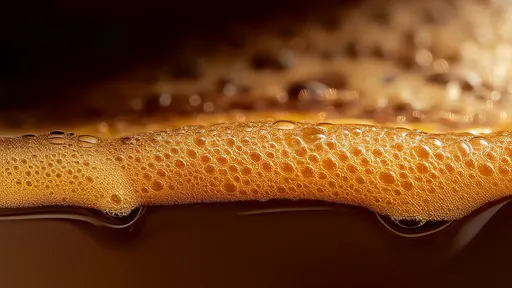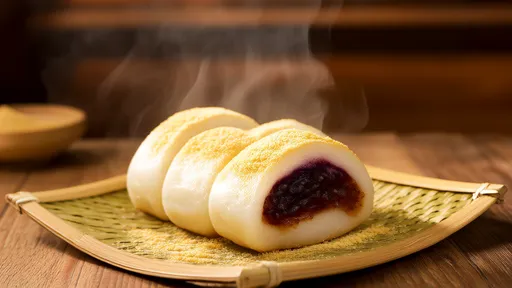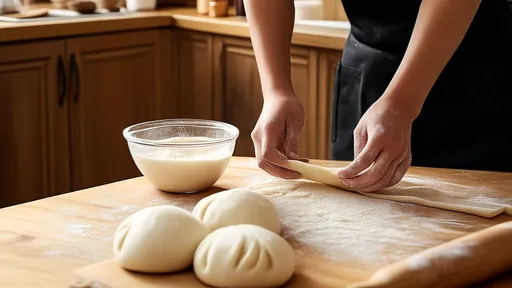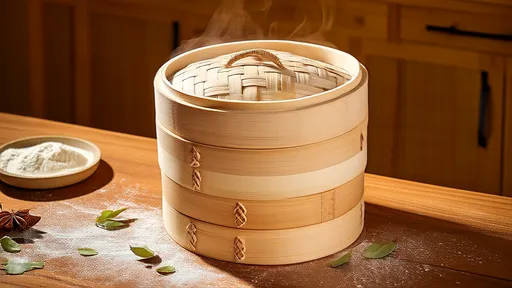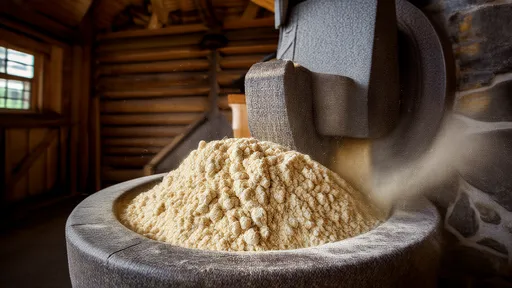The art of cooking perfect rice lies in understanding the gelatinization temperature of different japonica rice varieties. This scientific parameter, often overlooked by home cooks, determines the precise moment when starch granules absorb water and swell—fundamentally shaping texture, flavor release, and nutritional accessibility. Recent studies across Asian research institutions reveal how subtle genetic variations in short-grain rice cultivars create distinct thermal behaviors during cooking, challenging the one-size-fits-all approach to water ratios and heat application.
Gelatinization temperature isn't simply about reaching boiling point—it's a dance between crystalline starch structures and heat penetration. High-resolution differential scanning calorimetry (DSC) curves demonstrate that premium Japanese koshihikari begins its starch transition at 61°C, while Chinese Wuyoudao varieties require 67°C to initiate the same molecular transformation. This 6-degree divergence explains why traditional Japanese cooking methods employ a gradual temperature ramp, whereas northern Chinese techniques favor sustained high heat after initial soaking.
The most striking discovery emerges from time-temperature superposition experiments. When cooked at identical 100°C temperatures, low-gelatinization cultivars like Akitakomachi achieve complete starch conversion 23% faster than high-temperature varieties such as Nangeng. This explains the sensory paradox where some rices develop perfect texture in 12 minutes while others require 18 minutes despite similar grain dimensions. The phenomenon stems from differences in amylopectin branch-chain length distribution—a molecular signature shaped by centuries of selective breeding.
Water absorption patterns tell a parallel story. Through synchrotron X-ray microscopy, researchers observed that rice with lower gelatinization thresholds exhibits asymmetric hydration—the outer endosperm hydrates exponentially faster than the core. This creates the coveted texture gradient prized in Japanese takikomi gohan, where grains maintain structural integrity while achieving creamy consistency. In contrast, high-gelatinization rices like Korean Ilpum absorb water more uniformly, producing the distinctively firm yet sticky texture essential for bibimbap.
Industrial rice cookers have quietly revolutionized to accommodate these variations. Premium models now incorporate multi-stage heating profiles that mirror the gelatinization curves of specific rice DNA-registered varieties. A 2023 study published in Food Chemistry demonstrated that matching the cooker's temperature ramp rate to a rice's particular DSC curve improved taste panel scores by 41% compared to conventional cooking. The algorithm in Zojirushi's latest neuro-fuzzy logic models even adjusts for batch size—recognizing that thermal mass affects how quickly small quantities traverse the critical gelatinization window.
Climate change adds urgency to this research. As nighttime temperatures rise in traditional rice-growing regions, agronomists note a 0.8°C per decade increase in gelatinization thresholds among standard cultivars. This shift requires recalibration of cooking practices developed over generations. The International Rice Research Institute has identified three heat-resistant landraces from Hokkaido that maintain stable gelatinization properties under stress—genetic traits now being introduced into commercial varieties through marker-assisted selection.
Ancient cooking vessels offer unexpected insights. Analysis of iron kama pots used in Japanese monastery kitchens reveals their thermal inertia creates a 4-minute plateau at 72°C—precisely matching the secondary gelatinization peak of heritage sasanishiki rice. Modern copper-core cookware achieves similar effects through controlled heat rebound after the initial boil. This "temperature memory" phenomenon explains why certain rice varieties develop deeper flavor profiles in traditional cookware despite identical ingredient inputs.
The frontier of rice science now explores ultrasonic-assisted cooking. Early trials at Tsukuba University show that 40kHz sound waves can lower gelatinization onset by 3°C through micro-vibration of starch granules. This technology may soon enable perfect texture in high-altitude cooking where boiling points depress. Meanwhile, heritage grain advocates emphasize that understanding these thermal properties helps preserve heirloom varieties—their unique gelatinization signatures being as culturally significant as flavor or aroma.
As rice cultivation faces unprecedented environmental pressures, decoding the complex relationship between grain genetics and thermal behavior becomes not just a culinary pursuit, but a conservation imperative. The humble rice cooker may soon evolve into a precision instrument capable of reading a grain's molecular identity—transforming an ancient staple into a canvas for scientific innovation and cultural preservation.
The art of baking a perfect cake relies heavily on understanding the science behind its structure. Among the many factors that contribute to a cake's texture, the uniformity of air pockets within the cake crumb stands out as a critical element. This characteristic is largely influenced by the foaming properties of proteins in the batter, particularly those found in eggs. The way proteins trap and stabilize air bubbles during mixing directly impacts the final product's lightness, tenderness, and overall mouthfeel.
The world of sensory evaluation is as intricate as it is fascinating, particularly when it comes to understanding how we perceive flavors and aromas. Among the myriad of compounds that contribute to our sensory experiences, vanillin—the primary component of vanilla extract—stands out for its widespread use and complex interaction with our senses. The concept of odor threshold plays a pivotal role in determining how much of this compound is needed for it to be detectable, and it varies significantly depending on the medium in which it is presented.
The world of chili peppers is as diverse as it is fiery, with each variety packing its own unique punch. At the heart of understanding this heat lies the Scoville Scale, a measurement that quantifies the spiciness of peppers. Developed by Wilbur Scoville in 1912, this scale remains the gold standard for gauging the capsaicin content—the compound responsible for that burning sensation—in different peppers. From the mild bell pepper to the mind-numbing Carolina Reaper, the Scoville Scale offers a fascinating glimpse into the spectrum of heat that chili enthusiasts chase.
The culinary world has long celebrated the magic that happens when certain ingredients come together, creating flavors greater than the sum of their parts. One such pairing—chicken broth and mushrooms—exemplifies the scientific and gastronomic phenomenon known as umami synergy. This dynamic duo has been a staple in kitchens across cultures, from French consommé to Japanese ramen, and its power lies in the way their compounds interact to amplify savory depth.
The world of fermented foods is a fascinating intersection of microbiology, chemistry, and culinary tradition. Among these, kimchi stands out not only for its bold flavors but also for the intricate biochemical processes that transform raw vegetables into a probiotic-rich delicacy. At the heart of this transformation lies a phenomenon known as acetic acid penetration, which creates a dynamic pH gradient during fermentation. This process is far more than a simple souring of cabbage—it's a carefully orchestrated dance between microbial communities and their chemical environment.
The turbidity of fruit juice, often perceived as a mark of freshness and natural quality, is primarily governed by the suspension mechanisms of pulp particles. These tiny fragments of fruit flesh, ranging from cellular debris to larger fibrous clusters, create the characteristic cloudiness that consumers associate with premium products. Behind this seemingly simple phenomenon lies a complex interplay of physical forces, biochemical interactions, and processing variables that determine whether pulp remains evenly dispersed or separates over time.
The fizz in your soda isn't just about taste—it's a carefully engineered dance between gas and liquid that begins unraveling the moment you twist open the cap. Few consumers realize how precisely carbonation levels are calibrated, or how dramatically pressure dynamics shift during that first explosive release. This invisible physics experiment in every bottle follows predictable but fascinating patterns that beverage scientists have spent decades mapping.
The world of espresso is as complex as it is captivating, with its rich flavors and aromatic allure. At the heart of this complexity lies a seemingly simple yet scientifically intricate component: the crema. This golden-brown layer of foam that crowns a well-pulled shot of espresso is not just a visual delight but a fascinating study in colloidal stability. The interplay of oils, gases, and solids in espresso crema reveals a delicate balance that defines the quality and texture of the coffee.
The phenomenon of "cold turbidity" or "cream down" in tea has long intrigued both tea connoisseurs and scientists alike. This natural occurrence, where tea liquor turns cloudy upon cooling, is not merely an aesthetic curiosity but a window into the complex chemistry of tea. Recent advancements in optical measurement techniques have enabled researchers to quantify this phenomenon through turbidity detection based on tea liquor transmittance, opening new avenues for quality assessment and understanding of tea's molecular interactions.
The world of instant noodles thrives on convenience, but behind that simplicity lies a carefully engineered marvel of food science. At the heart of this innovation sits pregelatinized starch—an unsung hero that transforms dehydrated noodles into a steaming bowl of comfort within minutes. Unlike traditional starch, pregelatinized starch undergoes a thermal and mechanical treatment that breaks down its granular structure, allowing it to absorb water rapidly. This property is pivotal for instant noodles, where rehydration speed and texture determine consumer satisfaction.
The world of traditional fermented foods holds countless microbial secrets, and few are as fascinating as the complex ecosystem of laomian – the centuries-old sourdough starter that gives Chinese steamed bread its distinctive character. While modern bakeries increasingly rely on commercial yeast, artisanal producers across northern China still maintain their family laomian cultures like precious heirlooms, passing down not just techniques but living microbial communities through generations.
The sticky, chewy texture of glutinous rice cakes, known as mochi in Japanese or nuòmǐ cí in Chinese, has long been a staple in East Asian cuisine. These delectable treats, often enjoyed during festivals or as everyday snacks, owe their unique consistency to a key component: amylopectin, the branched-chain starch found in glutinous rice. However, anyone who has left mochi or Chinese mochi cakes (糍粑) at room temperature for a few hours will notice an unmistakable transformation—the once-soft and pliable dessert gradually hardens, becoming tougher and less enjoyable. This phenomenon, often referred to as retrogradation, is a fascinating interplay of chemistry, physics, and culinary science.
The art of cooking perfect rice lies in understanding the gelatinization temperature of different japonica rice varieties. This scientific parameter, often overlooked by home cooks, determines the precise moment when starch granules absorb water and swell—fundamentally shaping texture, flavor release, and nutritional accessibility. Recent studies across Asian research institutions reveal how subtle genetic variations in short-grain rice cultivars create distinct thermal behaviors during cooking, challenging the one-size-fits-all approach to water ratios and heat application.
The art of crafting perfect hand-pulled noodles lies in mastering the delicate balance between gluten development and dough relaxation. Among the many variables that influence noodle extensibility, resting time stands as one of the most critical yet often overlooked factors. This silent alchemy occurring during the waiting period transforms a stiff, unyielding mass into an elastic, cooperative material ready to be stretched into silky strands.
For generations, home cooks and professional chefs alike have relied on stainless steel containers for pickling and food storage. The material's reputation for durability and corrosion resistance makes it a seemingly ideal choice. But when acidic ingredients like vinegar enter the equation, questions arise about potential metal leaching and food safety. Understanding the interaction between stainless steel and pickling brines requires a deeper dive into metallurgy, chemistry, and culinary science.
The bamboo steamer, a centuries-old culinary tool cherished across Asian kitchens, operates on principles far more sophisticated than its simple appearance suggests. Among its most fascinating phenomena is the so-called "bamboo steamer effect" – a self-regulating mechanism that prevents the dreaded condensation drip-back, ensuring perfectly textured dumplings, buns, and fish every time. This natural engineering marvel has captivated chefs and scientists alike, revealing how traditional wisdom often anticipates modern food science.
The age-old practice of stone milling has long been revered for its ability to produce flour that retains the natural goodness of whole grains. Unlike modern industrial milling methods, which often prioritize speed and shelf life, stone grinding operates at a slower pace, preserving the integrity of the grain’s nutritional profile. One of the most significant advantages of this traditional method is its ability to maintain higher levels of dietary fiber in whole wheat flour—a component essential for digestive health, blood sugar regulation, and overall well-being.







